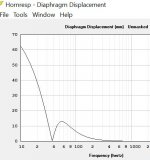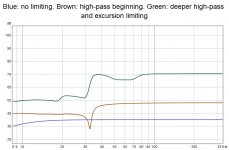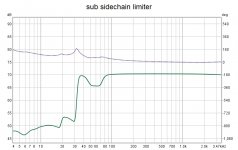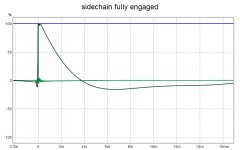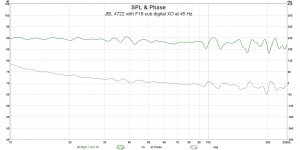Give me One reasonWhich Tracy Chapman?
//
Similar to mlee, I ran some tests on phase audibility using commercial DSP software to flatten the phase on a pair of speakers with passive XO. I could not really tell an audible difference with the FIR filter in or out of the signal path.
However, when I time aligned the drivers with a linear phase digital XO, that did make an audible difference (subtle) versus the passive XO with no time alignment, but phase corrected.
Hi Mitch
I am confused. If I have a two way speaker where the two drivers are not time aligned then there will be a phase shift at the crossover as the response transitions from one location to the other. If I now flatten the phase across the band then I have to time align the two drivers to achieve that. Hence, your first test and your second test are basically doing the same thing just in two different ways. You cannot assume that the differences that you hear were from the time alignment of the drivers because this was done in both cases. Something else must be the answer.
Camplo - nobody is talking TL because they don't work very well. I'd not go down that road if I were you.
Give me One reason
And "All That You Have is Your Soul."
Thanks for the information mitchba! Yes the step response should illustrate what we are speaking of a little better, makes sense.
Just to clarify, my setup was "time aligned" 2-way active setup implemented with IIR XOVER. Then I applied a FIR filter on top of that to linearise phase response. I did not redo the XOVER using FIR filters. Not sure the result would show any difference for me.
Thanks mlee for the clarification.
So no one here is experienced in TL design? You guys just avoided this build huh...lol
Hi camplo, I still think this design with the cab split internal into 3 sections was the best TL I have heard. See Figure 6: http://user.faktiskt.io/lennartj/Audio/Bailey-1972-Transmission-Line-Loudspeaker-Enclosure.pdf
Not sure how to scale for an 18" driver or how it would fit on the baffle...
Hi Mitch
I am confused. If I have a two way speaker where the two drivers are not time aligned then there will be a phase shift at the crossover as the response transitions from one location to the other. If I now flatten the phase across the band then I have to time align the two drivers to achieve that. Hence, your first test and your second test are basically doing the same thing just in two different ways. You cannot assume that the differences that you hear were from the time alignment of the drivers because this was done in both cases. Something else must be the answer.
Hi Earl, have you tried rePhase to linearize the phase on one of your existing speakers?
Here was the experiment.
2 way speaker, passive XO. Not time aligned. i.e. the woofer and tweeter have different z offsets.
Same speakers, with a FIR filter that linearized the phase. Same passive XO and drivers at same two different z distances.
A/B test with volume at the same level. Could not really hear a difference.
Same 2 way speaker, but biamped with a linear phase digital XO and the woofer and the tweeter still not time aligned, but phase linearized.
Same as above, except time aligned. i.e. the woofer was delayed 0.71 ms to line up with the acoustic center of the tweeter. Same linearized phase and frequency response
A/B test and can hear the difference in depth of field with time aligned versus non-time aligned. When I say time aligned, I mean the two drivers acoustic centers are aligned in time using a digital delay on one of the drivers to match the other's z offset.
Hi Mitch
I am confused. If I have a two way speaker where the two drivers are not time aligned then there will be a phase shift at the crossover as the response transitions from one location to the other. If I now flatten the phase across the band then I have to time align the two drivers to achieve that. Hence, your first test and your second test are basically doing the same thing just in two different ways. You cannot assume that the differences that you hear were from the time alignment of the drivers because this was done in both cases. Something else must be the answer.
This problem actually has another dimension. Consider the adjustments required to sort out the phase response on axis. These phase changes will effect the phase and frequency response off axis in a destructive manner.
These may be the subtle changes heard when using FIR to flatten on axis phase response. The room response is changing even though the on axis response is unchanged.
Are you referring to phase tracking?
For those who don't own the album, I've uploaded the 2 tracks mentioned, as well as the no. 1 in the Harman list.
2 different releases of the same tracks, so 6 in total (FLAC level 0).
For those who don't own the album, I've uploaded the 2 tracks mentioned, as well as the no. 1 in the Harman list.
2 different releases of the same tracks, so 6 in total (FLAC level 0).
Last edited:
Any phase errors that are caused by non coincident placement of the drivers, if corrected, will cause problems off axis. Imagine a HF driver on a WG above a woofer. Picture a 100mm difference in acoustic centre towards the rear on the compression driver. If you correct this by delaying the woofer then the acoustic center of the woofer is well behind the compression driver when viewed off axis. At 90 degrees off axis the acoustic center of the woofer is 100mm behind the compression driver, less so at smaller off axis angles.
Hi all, don't want to keep kicking a dead horse regarding why I don't see impulse and step as good tools to use for low frequency tuning.
But I've been working on something I think you might find interesting and kinda illustrates the lack of usefulness with those tools for low frequency work.
Anyway, the project has been to see if I could make a frequency dependent limiter that could act as both a high-pass filter, and a 'parametric' excursion limiter.
An excursion limiter that only engages smoothly in a specific range as drive level increases. So no traditional filters....
Reason for the project has been to get maximum output of Faital Pro 18FH500, avoiding over excursion and THD..
First pic below is Hornresp's Displacement screen for the driver at rated AES power in the bass-reflex box I built.
X-max is 9.3mm. You can see excursion above that between 45Hz and 75Hz at full power.
First REW screen shows a few stages of limiting kicking in...
1. none at low level, 2.high-pass substitute engaging as level increases, and 3. both high-pass and over-excursion-range fully in.
2nd REW screen is just SPL along with phase when the limiter is fully engaged.
3rd REW is impulse and step of previous SPL/phase.
Guys imo, this represents a lot of monkeying with bottom end response, and very little information provided by impulse or step of the altered response....
Anyway, also have to admit I just wanted to show this sidechain limiting experiment...I figure this thread has gone nearly everywhere so a little more sidetrack wouldn't hurt too much. thx
But I've been working on something I think you might find interesting and kinda illustrates the lack of usefulness with those tools for low frequency work.
Anyway, the project has been to see if I could make a frequency dependent limiter that could act as both a high-pass filter, and a 'parametric' excursion limiter.
An excursion limiter that only engages smoothly in a specific range as drive level increases. So no traditional filters....
Reason for the project has been to get maximum output of Faital Pro 18FH500, avoiding over excursion and THD..
First pic below is Hornresp's Displacement screen for the driver at rated AES power in the bass-reflex box I built.
X-max is 9.3mm. You can see excursion above that between 45Hz and 75Hz at full power.
First REW screen shows a few stages of limiting kicking in...
1. none at low level, 2.high-pass substitute engaging as level increases, and 3. both high-pass and over-excursion-range fully in.
2nd REW screen is just SPL along with phase when the limiter is fully engaged.
3rd REW is impulse and step of previous SPL/phase.
Guys imo, this represents a lot of monkeying with bottom end response, and very little information provided by impulse or step of the altered response....
Anyway, also have to admit I just wanted to show this sidechain limiting experiment...I figure this thread has gone nearly everywhere so a little more sidetrack wouldn't hurt too much. thx
Attachments
Mark, your contributions are most interesting and useful, so keep them coming.
I don't expect camplo to disagree, aside from the fact that your post deals with BR instead of TL
In this thread, a number of pros shed their light on linear phase and FIR filters.
To quote Peter Morris' quote of Lipshitz:
“Using pre-recorded music (male & female singing) fed through a 2nd-order all-pass network, with a Q of .5, audible effects were noted with a 95% confidence level. Using a variety of unpitched sounds recorded anechoically, phase effects were again audible.”
I don't expect camplo to disagree, aside from the fact that your post deals with BR instead of TL
In this thread, a number of pros shed their light on linear phase and FIR filters.
To quote Peter Morris' quote of Lipshitz:
“Using pre-recorded music (male & female singing) fed through a 2nd-order all-pass network, with a Q of .5, audible effects were noted with a 95% confidence level. Using a variety of unpitched sounds recorded anechoically, phase effects were again audible.”
Hi Earl, have you tried rePhase to linearize the phase on one of your existing speakers?
Here was the experiment.
2 way speaker, passive XO. Not time aligned. i.e. the woofer and tweeter have different z offsets.
Same speakers, with a FIR filter that linearized the phase. Same passive XO and drivers at same two different z distances.
A/B test with volume at the same level. Could not really hear a difference.
Same 2 way speaker, but biamped with a linear phase digital XO and the woofer and the tweeter still not time aligned, but phase linearized.
Same as above, except time aligned. i.e. the woofer was delayed 0.71 ms to line up with the acoustic center of the tweeter. Same linearized phase and frequency response
A/B test and can hear the difference in depth of field with time aligned versus non-time aligned. When I say time aligned, I mean the two drivers acoustic centers are aligned in time using a digital delay on one of the drivers to match the other's z offset.
I have not used rephase - it's not convenient in my system. But I did measure the phase in the system and found that it was naturally fairly flat with < 90 shift across the band. Hence, I doubted that much would be gained from flattening it any more.
As to your experiment I can't really explain what you hear. But I can say that the results of linearizing the phase of the passive crossover should have resulted in the exact same response as when you linearized the phase after using some woofer delay. In the first example, if correctly done, the filter would have to have put in the same woofer delay as the second test or the phase could not have been linear.
It may well be that limitations in the algorithms will make the actual implementations different, but in theory, if both were working as suggested, they should be identical.
I am not a strong advocate of linear phase as a major perceptual aspect of reproduction, but I certainly do not discount that it can make some difference in systems with a radical phase shift across the band. Systems like mine that are naturally phase linear (unlike most two ways) are not really going to benefit very much by a further linearizing of the phase.
This problem actually has another dimension. Consider the adjustments required to sort out the phase response on axis. These phase changes will effect the phase and frequency response off axis in a destructive manner.
In the context of what I am saying, the off axis of the two different means of correcting the phase will also have identical off axis changes - good or bad. Of course they will both have different off axis responses than the uncorrected speakers.
Any phase errors that are caused by non coincident placement of the drivers, if corrected, will cause problems off axis.
Maybe "problems" is the wrong word, because the off axis changes may be beneficial. What one has to do with crossovers is to design them for the total polar field and not just on-axis. I have always done this and developed my software specifically to allow me to do this. Designing only for axial response is a serious error. One must consider the entire polar response as equally important to the listening axis response. One problem that I have had with this whole thread is the lack of consideration given to polar response - this will be a serious limitation to the conclusions.
Systems like mine that are naturally phase linear (unlike most two ways) are not really going to benefit very much by a further linearizing of the phase.
Would you mind to provide a brief explanation of this statement?
One problem that I have had with this whole thread is the lack of consideration given to polar response - this will be a serious limitation to the conclusions.
What's the (absolute) relevance of polar response if one's intention is to cover 200-20.000Hz by using a single horn/driver, under acceptance of a small sweetspot?
Last edited:
Would you mind to provide a brief explanation of this statement?
In my system the CD is mounted well back of the woofer. The woofer LP filter will delay the woofer which, in my case, is just enough to time align them. In non-horn two ways where the tweeter is in the same plane as the woofer this is not going to be the case and substantial phase anomalies will occur unless correct via techniques like Mitch's.
What's the (absolute) relevance of polar response if one's intention is to cover 200-20.000Hz by using a single horn/driver, under acceptance of a small sweetspot?
In an anechoic chamber this is true, but in real rooms it is not. At a typical listening situation there is as much as or more energy in the reverberant field as there is in the direct field (this depends on the listening distance and room characteristics, etc., but seldom would the reverberant energy be negligible) To think that this energy does not affect the perception is simply nieve.
Hi Earl, understood. I need to isolate down to a single variable to test to really find what is causing the difference.
Also, like you, I am a bit confounded on why polar response is not high up on the list of horn/waveguide evaluations. I have tried many a horn, most turn out having bad polars (i.e. not only uneven frequency dependant, but beaming at high frequencies) and drove me nuts when just moving my head an inch of two and the mid/high frequency response significantly changed, both in measurements and listening. That's why I went CD and never looked back.
I know I linked to it before, but there is an ANSI/CTA "Standard Method of Measurement for In-Home Loudspeakers" in which folks can download for free. This is based on Floyd Tooles and Sean Olives extensive "spinorama" measurement methodology and correlating it to subjective listening tests of what makes for a good sounding loudspeaker in a typical listening room.
From the standard, "This standard describes an improved method for measuring and reporting the performance of a loudspeaker in a manner that should help consumers better understand the performance of the loudspeaker and convey a reasonably good representation of how it may sound in a room based on its off-axis response and how this response affects the consumer’s experience. It also describes how to use this directivity data to estimate the in-room frequency response that more recent research has shown correlates well to subjective listening preferences of consumers."
@Mark, maybe we are saying the same thing? Or am I missing something? Attached is the amplitude and phase response of my system in the low end measured at the LP that correlates to the step response I posted earlier.
Also, like you, I am a bit confounded on why polar response is not high up on the list of horn/waveguide evaluations. I have tried many a horn, most turn out having bad polars (i.e. not only uneven frequency dependant, but beaming at high frequencies) and drove me nuts when just moving my head an inch of two and the mid/high frequency response significantly changed, both in measurements and listening. That's why I went CD and never looked back.
I know I linked to it before, but there is an ANSI/CTA "Standard Method of Measurement for In-Home Loudspeakers" in which folks can download for free. This is based on Floyd Tooles and Sean Olives extensive "spinorama" measurement methodology and correlating it to subjective listening tests of what makes for a good sounding loudspeaker in a typical listening room.
From the standard, "This standard describes an improved method for measuring and reporting the performance of a loudspeaker in a manner that should help consumers better understand the performance of the loudspeaker and convey a reasonably good representation of how it may sound in a room based on its off-axis response and how this response affects the consumer’s experience. It also describes how to use this directivity data to estimate the in-room frequency response that more recent research has shown correlates well to subjective listening preferences of consumers."
@Mark, maybe we are saying the same thing? Or am I missing something? Attached is the amplitude and phase response of my system in the low end measured at the LP that correlates to the step response I posted earlier.
Attachments
In the context of what I am saying, the off axis of the two different means of correcting the phase will also have identical off axis changes - good or bad. Of course they will both have different off axis responses than the uncorrected speakers.
Maybe "problems" is the wrong word, because the off axis changes may be beneficial. What one has to do with crossovers is to design them for the total polar field and not just on-axis. I have always done this and developed my software specifically to allow me to do this. Designing only for axial response is a serious error. One must consider the entire polar response as equally important to the listening axis response. One problem that I have had with this whole thread is the lack of consideration given to polar response - this will be a serious limitation to the conclusions.
In the context of brute force FIR phase correction I don't believe there is any way to discriminate between correcting phase wrap caused by the crossovers Vs that caused by non coincident drivers. I'd happily correct for the former but not the latter if possible.
@Mark, maybe we are saying the same thing? Or am I missing something? Attached is the amplitude and phase response of my system in the low end measured at the LP that correlates to the step response I posted earlier.
Hi Mitch, I very much think we are saying the same thing.....how impulse and step are favored by highs and mids.….
In my last post I was trying to display how convoluted the low end can get and still have a near perfect impulse and step...
And in all honesty, maybe show off a little too
Also, like you, I am a bit confounded on why polar response is not high up on the list of horn/waveguide evaluations. I have tried many a horn, most turn out having bad polars (i.e. not only uneven frequency dependant, but beaming at high frequencies) and drove me nuts when just moving my head an inch of two and the mid/high frequency response significantly changed, both in measurements and listening. That's why I went CD and never looked back.
Agreed
- Home
- Loudspeakers
- Multi-Way
- Is it possible to cover the whole spectrum, high SPL, low distortion with a 2-way?
